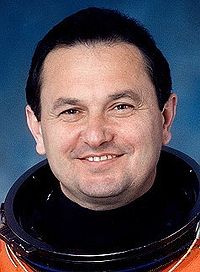Vladimir Georgiyevich Titov
Russian - (RFSA)
Retired
Date of Birth: Jan. 1, 1947
Age: 78
Vladimir Georgiyevich Titov (Russian: Владимир Георгиевич Титов; born 1 January 1947 in Sretensk, Zabaykalsky Krai, Russia) is a retired Russian Air Force Colonel and former cosmonaut. He has participated in four spaceflight missions. The catastrophic explosion of a Soyuz rocket in 1983 led to him being one of only two people to use a launch escape system.
Soyuz-U | Soyuz T-8
Russian Federal Space Agency (ROSCOSMOS) | RussiaBaikonur Cosmodrome, Republic of Kazakhstan
April 20, 1983, 1:10 p.m.
Status: Success
Mission:
Soyuz T-8 was meant to be the fourth mission to visit the Salyut 7 space station. The mission began on April 20, 1983, 13:10:54 UTC, launching Commander Vladimir Titov, Flight Engineer Gennady Strekalov and Research Cosmonaut Aleksandr Serebrov into orbit. However, the spacecraft failed to dock with the space station and after some further attempts mission had to be aborted. The mission concluded two days later with a safe landing back on Earth on April 22, 1983, 13:28:42 UTC.
Low Earth OrbitSoyuz-U | Soyuz 7K-ST No.16L (Soyuz T-10a / T-10-1)
Russian Federal Space Agency (ROSCOSMOS) | RussiaBaikonur Cosmodrome, Republic of Kazakhstan
Sept. 26, 1983, 7:37 p.m.
Status: Failure
Mission:
Soyuz T-10a, also known as T-10-1, was supposed to be the third long-duration expedition to the Salyut 7 space station. The mission would have launched Commander Vladimir Titov and Flight Engineer Gennady Strekalov on September 26, 1983, 19:37:49 UTC, however the launch vehicle was destroyed on the launch pad by fire. The launch escape system in the Soyuz spacecraft fired two seconds before the launch vehicle exploded, saving the crew. It is so far the only case in which a launch escape system has been fired with a crew aboard.
Low Earth OrbitSoyuz-U2 | Soyuz TM-4
Soviet Space Program | RussiaBaikonur Cosmodrome, Republic of Kazakhstan
Dec. 21, 1987, 11:18 a.m.
Status: Success
Mission:
Soyuz TM-4 was the fourth mission to Mir space station. The mission began on December 21, 1987, 11:18:03 UTC, launching Commander Vladimir Titov, Flight Engineer Musa Manarov and Research Cosmonaut Anatoli Levchenko into orbit. They docked with Mir two days later. During their stay there, crew carried out over 2000 various experiments, performed two EVAs. They were visited by Soyuz TM-5 and Soyuz TM-6 crews. Vladimir Levchenko spent only a week on the station, while other two members of the crew stayed for a long duration mission. They returned on a Soyuz TM-6 spacecraft, landing safely back on Earth on December 21, 1988, 09:57:00 UTC.
Low Earth OrbitSoyuz-U2 | Soyuz TM-6
Soviet Space Program | RussiaBaikonur Cosmodrome, Republic of Kazakhstan
Aug. 29, 1988, 4:23 a.m.
Status: Success
Mission:
Soyuz TM-6 was the sixth mission to Mir space station. The mission began on June 7, 1988, 14:03:13 UTC, launching Commander Vladimir Lyakhov, Flight Engineer/Research Doctor Valeri Polyakov and Research Cosmonaut Abdul Mohmand, the first Afghan cosmonaut, into orbit. They docked with Mir two days later, meeting with the long-duration resident crew. During their 7-day stay there, cosmonauts performed Earth observation and other tasks. They returned on a Soyuz TM-5 spacecraft, landing safely back on Earth on September 7, 1988, 00:49:38 UTC.
Low Earth OrbitSpace Shuttle Discovery / OV-103 | STS-63
National Aeronautics and Space Administration | United States of AmericaKennedy Space Center, FL, USA
Feb. 3, 1995, 5:22 a.m.
Status: Success
Mission:
STS-63 was the first mission of the US/Russian Shuttle-Mir Program, which carried out the first rendezvous of the American Space Shuttle with Russia's space station Mir. Known as the 'Near-Mir' mission, the flight used Space Shuttle Discovery, which lifted off from launch pad 39B on 3 February 1995 from Kennedy Space Center, Florida.
Low Earth OrbitSpace Shuttle Atlantis / OV-104 | STS-86
National Aeronautics and Space Administration | United States of AmericaKennedy Space Center, FL, USA
Sept. 26, 1997, 2:34 a.m.
The Roscosmos State Corporation for Space Activities, commonly known as Roscosmos, is the governmental body responsible for the space science program of the Russian Federation and general aerospace research. Soyuz has many launch locations the Russian sites are Baikonur, Plesetsk and Vostochny however Ariane also purchases the vehicle and launches it from French Guiana.
Soyuz 2.1a
Obzor-R No.1
43/4 (43R) - Plesetsk Cosmodrome, Russian FederationNote: Assignment of payloads to this launch is uncertain. The Russian Obzor-R satellite is a planned X-band radar earth observation satellite desi…
LVM-3 (GSLV Mk III)
BlueBird Block 2 #1
Satish Dhawan Space Centre Second Launch Pad - Satish Dhawan Space Centre, IndiaAST SpaceMobile’s Block 2 BlueBird satellites are designed to deliver up to 10 times the bandwidth capacity of the BlueBird Block 1 satellites, requi…
Long March 12A
Demo Flight
Long March 12A Pad - Jiuquan Satellite Launch Center, People's Republic of ChinaFirst test launch of CASC/SAST’s Long March 12A rocket, with a dummy payload. The rocket’s 1st stage attempted to land on a landing pad about 300 km …
HANBIT-Nano
Spaceward
HANBIT Pad - Alcântara Space Center, Federative Republic of BrazilMaiden orbital launch attempt for the South Korean start-up Innospace and its HANBIT-Nano small launch vehicle. Onboard this flight are five small sa…
H3-22
Michibiki 5 (QZS-5)
Yoshinobu Launch Complex LP-2 - Tanegashima Space Center, JapanQZSS (Quasi Zenith Satellite System) is a Japanese satellite navigation system operating from inclined, elliptical geosynchronous orbits to achieve o…





